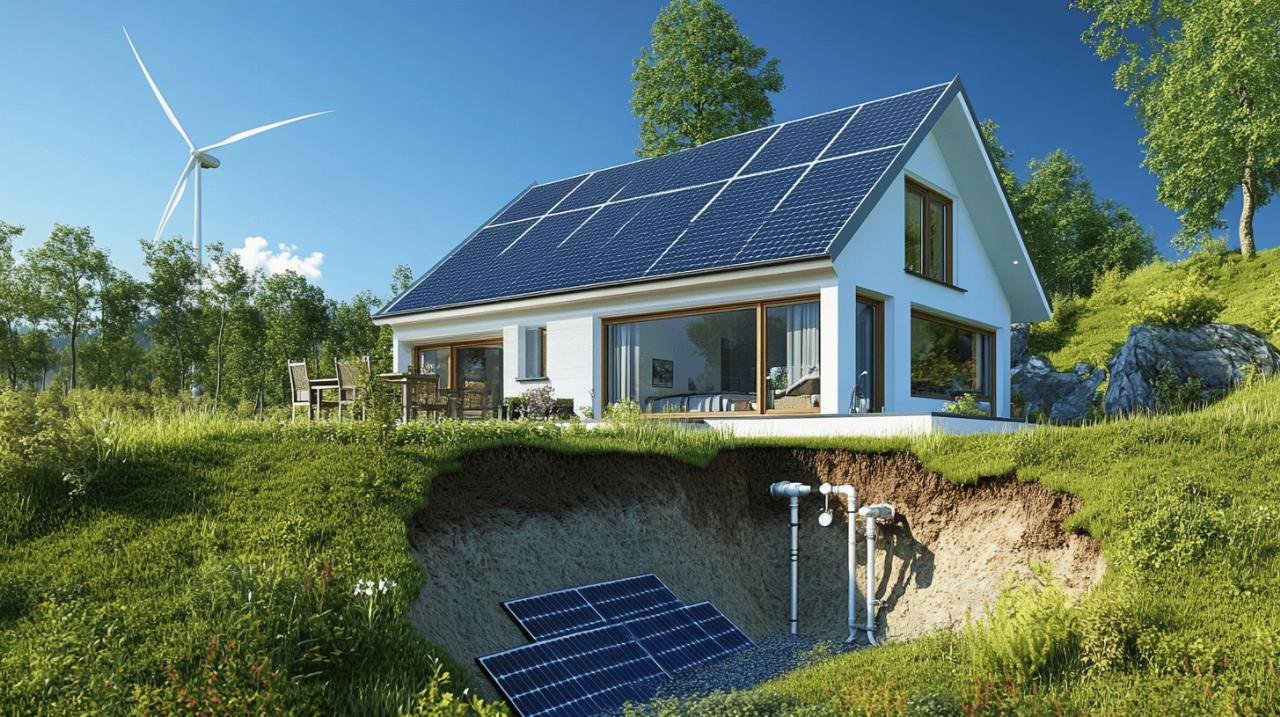Keeping a home warm during the colder months is a challenge familiar to many across the United Kingdom, and the quest to achieve a comfortable indoor climate often leads to soaring energy bills and a nagging environmental conscience. The good news is that a combination of practical improvements to your property and the adoption of alternative heating technologies can transform your living space into a haven of warmth and efficiency. This guide explores the key strategies for reducing heat loss and introduces ecological heating options that promise both comfort and sustainability.
Understanding heat loss: why your home feels like a fridge
The sensation of a perpetually cold house is not merely a matter of perception; it is often the result of heat escaping through various parts of the building fabric. In many older properties, warmth slips away silently through poorly insulated walls, roofs, and floors, leaving residents shivering despite the central heating working overtime. Understanding where and why this happens is the first step towards reclaiming control over your energy consumption and comfort levels.
Common culprits behind escaping warmth
The walls of a typical home are responsible for a significant portion of heat loss, with uninsulated structures allowing as much as thirty-five per cent of warmth to drift away into the atmosphere. Roofs and lofts contribute another quarter of the total heat loss, while floors account for roughly ten per cent. Windows and doors, though often overlooked, also play a role in letting cold air seep in and warm air escape, particularly if they are single-glazed or poorly fitted. Even chimneys and ventilation points, necessary for air circulation, can inadvertently become conduits for heat loss if not properly managed. The cumulative effect of these factors means that many households are effectively heating the outdoors, a situation that is both financially draining and environmentally unsustainable.
Calculating the True Cost of Poor Insulation
The financial implications of an inadequately insulated home extend far beyond the immediate discomfort of chilly rooms. Modern gas boilers, which can achieve efficiency ratings of up to ninety-eight and a half per cent, are often hampered by the fact that the heat they generate is not retained within the building. Without proper insulation, homeowners may find themselves spending substantial sums each year simply to maintain a tolerable temperature. Installing effective loft insulation, for instance, can lead to annual savings of around two hundred and seventy pounds for a typical three-bedroom semi-detached property, while also reducing carbon emissions by six hundred kilograms. Cavity wall insulation offers similar benefits, with potential savings of two hundred and forty pounds and a reduction of six hundred and fifty kilograms of carbon emissions per year. These figures underscore the importance of addressing heat loss as a priority, not only to lower energy bills but also to contribute to broader environmental goals. Furthermore, improving the thermal performance of your home can enhance its Energy Performance Certificate rating, potentially increasing its resale value by around twenty per cent and helping it sell up to five per cent faster.
Heat pumps: the future of energy-efficient home heating
As the drive towards greener living intensifies, heat pumps have emerged as a compelling alternative to traditional heating systems. These devices work by extracting heat from the outside air or ground and transferring it indoors, a process that remains effective even in colder climates. The technology relies on a refrigeration cycle that amplifies the extracted heat, making it suitable for warming homes with remarkable efficiency. Unlike conventional electric heaters, heat pumps can deliver significantly more heat energy than the electrical energy they consume, making them an attractive option for those seeking to reduce both their carbon footprint and their energy bills.
Air source versus ground source: which suits your property
When considering a heat pump, one of the primary decisions involves choosing between an air source and a ground source system. Air source heat pumps are generally easier and less expensive to install, as they only require an external unit placed outside the property. They draw heat from the ambient air and are well-suited to most homes, particularly those with sufficient outdoor space for the unit. Ground source heat pumps, on the other hand, extract heat from the earth via a network of underground pipes. While they tend to offer slightly higher efficiency and more consistent performance throughout the year, the installation process is more complex and costly, often involving significant excavation work. The choice between the two systems will depend on factors such as the size of your property, the available land, and your budget. Both options, however, share the advantage of being capable of providing cooling during warmer months, adding a layer of versatility to their appeal.
Installation considerations and running costs explained
The installation of a heat pump requires careful planning and professional expertise to ensure optimal performance. An energy assessment of your home is a crucial first step, as it helps determine the appropriate size and type of system for your needs. Factors such as the existing insulation, the layout of your property, and your heating requirements all play a role in this decision. Once installed, heat pumps generally have lower running costs compared to traditional heating systems, although the initial investment can be substantial. Government incentives and grants may be available to help offset these upfront costs, making the transition more financially viable. It is also important to consider the long-term savings and environmental benefits, as heat pumps can dramatically reduce reliance on fossil fuels and lower household carbon emissions. Regular maintenance is relatively straightforward, and with proper care, these systems can provide reliable heating for many years, making them a sound investment in both comfort and sustainability.
Traditional warmth reimagined: modern wood-burning solutions
 For those who appreciate the charm and ambiance of a real fire, modern wood-burning stoves offer a way to enjoy traditional warmth while adhering to contemporary environmental standards. Advances in stove technology have led to designs that are far more efficient and cleaner-burning than their predecessors, making them a viable option for eco-conscious homeowners. These appliances can provide a substantial amount of heat, often enough to warm an entire living space, and they add a distinctive character to any home. When used responsibly and with sustainably sourced fuel, wood-burning stoves can be a practical and environmentally friendly heating solution.
For those who appreciate the charm and ambiance of a real fire, modern wood-burning stoves offer a way to enjoy traditional warmth while adhering to contemporary environmental standards. Advances in stove technology have led to designs that are far more efficient and cleaner-burning than their predecessors, making them a viable option for eco-conscious homeowners. These appliances can provide a substantial amount of heat, often enough to warm an entire living space, and they add a distinctive character to any home. When used responsibly and with sustainably sourced fuel, wood-burning stoves can be a practical and environmentally friendly heating solution.
Selecting a Low-Emission Stove for Your Living Space
Choosing the right wood-burning stove involves more than simply picking a design that appeals to your aesthetic sensibilities. It is essential to look for models that are certified for low emissions, as these stoves are engineered to burn wood more completely and efficiently, releasing fewer pollutants into the atmosphere. Certification schemes provide assurance that a stove meets stringent performance standards, and opting for such a model demonstrates a commitment to reducing your environmental impact. The size and heat output of the stove should also be matched to the dimensions of the room in which it will be installed, as an oversized unit can lead to overheating and inefficient fuel use, while an undersized one may struggle to provide adequate warmth. Consulting with a qualified heating engineer or stove specialist can help ensure that you select a model that is both effective and compliant with local regulations.
Sourcing sustainable fuel and maintenance best practices
The environmental credentials of a wood-burning stove are heavily dependent on the type of fuel used. Sustainably sourced wood, ideally from certified forestry operations, ensures that the carbon released during combustion is balanced by the carbon absorbed by new tree growth. It is also important to use properly seasoned or kiln-dried wood, as burning damp or green wood can lead to incomplete combustion, increased emissions, and a build-up of creosote in the chimney. Regular maintenance is key to keeping a wood-burning stove operating safely and efficiently. This includes cleaning the glass, emptying the ash pan, and having the chimney swept at least once a year to prevent blockages and reduce the risk of chimney fires. By adhering to these best practices, homeowners can enjoy the warmth and ambiance of a wood fire while minimising their environmental footprint and ensuring the longevity of their heating appliance.
Solar thermal systems: capturing sunshine to heat your home
Solar thermal systems represent another innovative approach to home heating, harnessing the power of the sun to warm water for domestic use and central heating. Unlike solar photovoltaic panels, which generate electricity, solar thermal panels focus on capturing and transferring heat. These systems can be integrated with existing heating infrastructure, providing a renewable source of energy that reduces reliance on fossil fuels and lowers energy bills. While the initial investment can be significant, the long-term savings and environmental benefits make solar thermal technology an increasingly popular choice for those looking to embrace sustainable living.
How solar water heating integrates with existing systems
One of the key advantages of solar thermal systems is their compatibility with conventional heating setups. The panels, typically installed on a south-facing roof to maximise sun exposure, collect heat and transfer it to a fluid that circulates through the system. This heated fluid then warms water stored in a tank, which can be used for taps, showers, and radiators. In most cases, a backup heating source, such as a boiler, is retained to ensure a consistent supply of hot water during periods of low sunlight. The integration process is relatively straightforward, and with careful planning, a solar thermal system can complement an existing heating setup seamlessly. Homeowners should work with qualified installers to ensure that the system is correctly sized and configured to meet their specific needs, taking into account factors such as household size, water usage patterns, and the available roof space.
Long-Term Savings and Environmental Benefits of Solar Investment
The financial appeal of solar thermal systems lies in their ability to significantly reduce the cost of heating water, which accounts for a substantial portion of household energy consumption. Although the upfront costs can be considerable, the savings on energy bills accumulate over time, often leading to a payback period of several years. Beyond the financial aspect, the environmental benefits are equally compelling. By generating heat from a renewable source, solar thermal systems help to lower carbon emissions and reduce dependence on non-renewable energy sources. This aligns with broader efforts to combat climate change and promotes a more sustainable approach to home heating. Additionally, homes equipped with solar thermal systems may enjoy an improved Energy Performance Certificate rating, enhancing their market value and appeal to prospective buyers who prioritise energy efficiency. With proper maintenance, which is generally minimal, solar thermal panels can provide reliable service for decades, making them a sound long-term investment in both economic and environmental terms.




